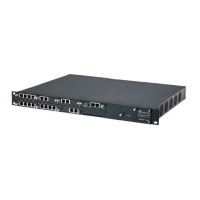User's Manual 460 Document #: LTRT-10632
Mediant 800B Gateway & E-SBC
Parameter Description
transferee receives RTP stream from the transfer target. If it has
not been detected, the device generates a ringback tone to the
transferee and stops the tone generation once RTP has been
detected from the transfer target.
For any of these scenarios, if the transferee is put on-hold by the
transferor, the device retrieves the transferee from hold, sends a re-
INVITE if necessary, and then plays the ringback tone.
Note: For the device to play the ringback tone, it must be loaded with
a Prerecorded Tones (PRT) file. For more information, see
Prerecorded Tones File on page 838.
Remote 3xx Mode
sbc-rmt-3xx-behavior
[IpProfile_SBCRemote3xxBe
havior]
Defines the device's handling of SIP 3xx redirect responses for the
SIP entity associated with the IP Profile. By default, the device's
handling of SIP 3xx responses is to send the Contact header
unchanged. However, some SIP entities may support different
versions of the SIP 3xx standard while others may not even support
SIP 3xx.
When enabled, the device handles SIP redirections between different
subnets (e.g., between LAN and WAN sides). This is required when
the new address provided by the redirector (Redirect sever) may not
be reachable by the far-end user (FEU) located in another subnet. For
example, a far-end user (FEU) in the WAN sends a SIP request via
the device to a Redirect server in the LAN, and the Redirect server
replies with a SIP 3xx response to a PBX in the LAN in the Contact
header. If the device sends this response as is (i.e., with the original
Contact header), the FEU is unable to reach the new destination.
[0] Transparent = (Default) The device forwards the received SIP
3xx response as is, without changing the Contact header
(i.e.,transparent handling).
[1] Database URL = The device changes the Contact header so
that the re-route request is sent through the device. The device
changes the URI in the Contact header of the received SIP 3xx
response to its own URI and adds a special user prefix ("T~&R_”),
which is then sent to the FEU. The FEU then sends a new INVITE
to the device, which the device then sends to the correct
destination.
[2] Handle Locally = The device handles SIP 3xx responses on
behalf of the dialog-initiating UA and retries the request (e.g.,
INVITE) using one or more alternative URIs included in the 3xx
response. The device sends the new request to the alternative
destination according to the IP-to-IP Routing table (the 'Call
Trigger' field must be set to 3xx).
Note:
When the parameter is changed from 1 to 0, new 3xx Contact
headers remain unchanged. However, requests with the special
prefix continue using the device's database to locate the new
destination.
Only one database entry is supported for the same host, port, and
transport combination. For example, the following URLs cannot be
distinguished by the device:
sip:10.10.10.10:5060;transport=tcp;param=a
sip:10.10.10.10:5060;transport=tcp;param=b
The database entry expires two hours after the last use.
The maximum number of destinations (i.e., database entries) is 50.

